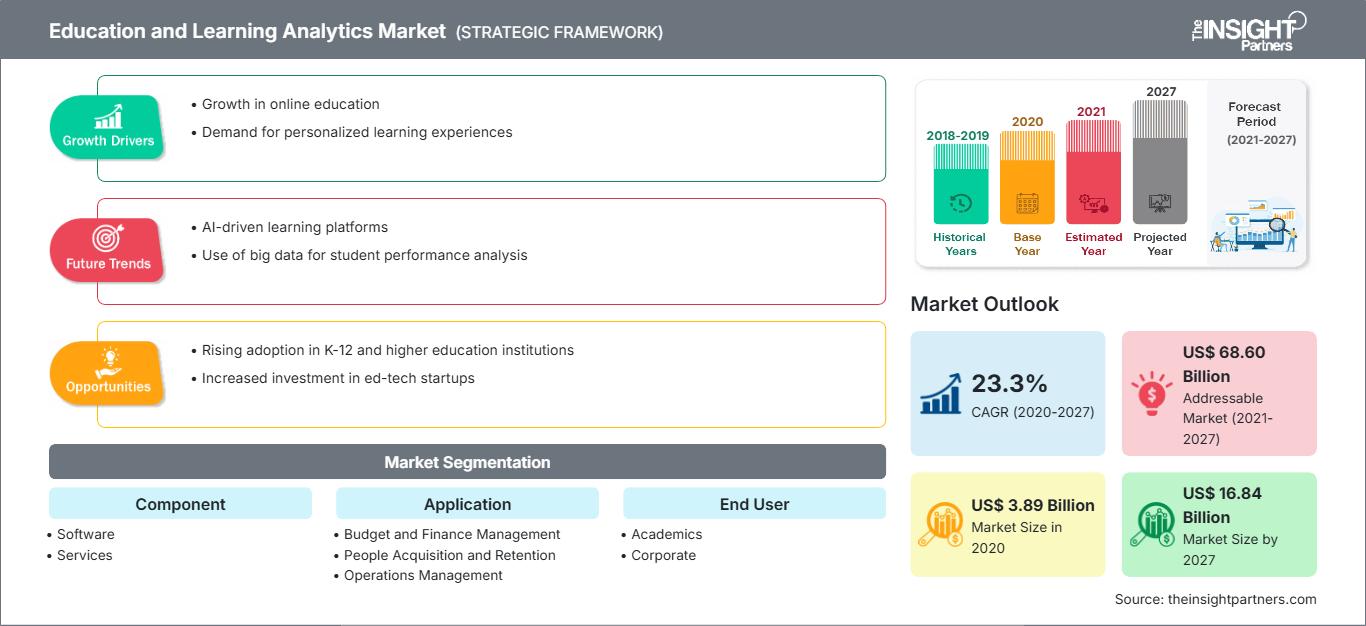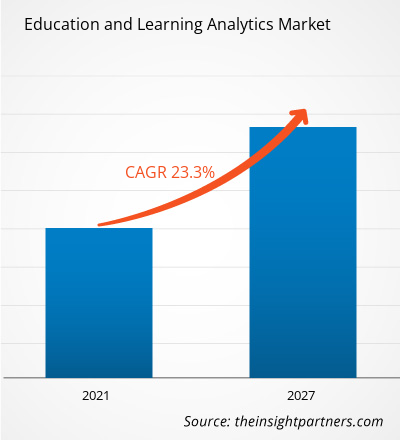[研究报告]教育和学习分析市场预计将从 2020 年的 38.903 亿美元增长到 2027 年的 168.359 亿美元;预计 2020 年至 2027 年的复合年增长率为 23.3%。
对在线课程和专业认证的需求不断增长,推动了市场的增长。对在线课程的需求不断增长以及在线课程注册数量的急剧增加,为教育和学习分析市场的供应商创造了巨大的机会。由于全球市场上存在大量参与者,在线课程市场高度分散。学习分析供应商必须专注于与在线课程提供商建立合作伙伴关系,以扩大其全球影响力。
在线学习正在成为教育领域的重要组成部分。越来越多的学生寻求灵活的证书、课程和学位课程形式,以支持职业发展和深造,这推动了在线课程的招生。已注册校内课程的学生也倾向于在入学期间注册混合式或全在线课程。在线硕士学位在学生中日益流行,因为许多知名大型院校正在转向各种在线学位课程,因为在线学位课程在学习体验中提供了高质量的技术支持。此外,企业专业人士也致力于学习各种课程以促进职业发展。因此,在线课程需求的激增预计将为全球教育和学习分析供应商提供巨大的机遇。
自定义此报告以满足您的要求
您将免费获得任何报告的定制,包括本报告的部分内容,或国家级分析、Excel 数据包,以及为初创企业和大学提供超值优惠和折扣
教育和学习分析市场: 战略洞察

- 获取本报告的主要市场趋势。这个免费样本将包括数据分析,从市场趋势到估计和预测。
COVID-19 疫情对教育和学习分析市场的影响
您将免费获得任何报告的定制,包括本报告的部分内容,或国家级分析、Excel 数据包,以及为初创企业和大学提供超值优惠和折扣
教育和学习分析市场: 战略洞察

- 获取本报告的主要市场趋势。这个免费样本将包括数据分析,从市场趋势到估计和预测。
尽管人们对 COVID-19 可能造成的损害持有不同观点,但事实是,COVID-19 正在全球蔓延。美国、加拿大、欧洲、非洲、中东、印度、澳大利亚、韩国、日本等多个国家的新增病例都在增加。尽管疫情对各类企业的影响众所周知,但教育行业也正面临着近年来最大的冲击。
为了应对旅行禁令和隔离措施,世界各地的教育机构纷纷转向在线学习。这场紧急情况可能会引发在线教育的热潮——或者至少可以让各国更好地应对下一次紧急情况
市场洞察——教育和学习分析市场
发展中国家的教育机构越来越多地采用先进技术
教育机构正在大力投资先进技术,以获得竞争优势并采用最佳的教育系统。另一方面,学生也愿意投资以获得最好的教育。教育机构和学生都有很大潜力投资于技术驱动的教育系统,这对市场增长产生了很大的影响。学校和大学正在投资技术以改善其教育运作,例如财务规划、课程规划、学生保留以及向学生传递信息的有效过程。
教育部门已经尝试了各种各样的技术进步,从课堂课程到基于应用程序的学习。其中一些技术已经成为高等教育系统的永久组成部分。快速发展的技术正在改变教育行业。
大数据分析等先进技术为教育工作者提供了前所未有的机会,使他们能够以新的方式与学生沟通。它能够更深入地了解学生的学习体验,也有助于评估教育系统的现状。大数据在教育领域发挥关键作用的一些关键领域包括定制课程、提高学生成绩、降低辍学率等。同样,学习分析能够改进课程交付流程、绩效管理、运营管理、财务管理等。所有这些与技术相关的优势都使教育机构能够采用智能技术解决方案。预计在预测期内,教育领域越来越多地采用先进技术解决方案将推动全球教育和学习分析市场的发展。
基于组件的洞察
基于组件,教育和学习分析市场细分为软件和服务。软件领域在2019年占据了最大的市场份额。
教育和学习分析市场的参与者主要专注于开发先进高效的产品。
- 2019年,SAS Institute Inc. 投资了分析背后的人才,以帮助教育新一代人去改变一切可能,并为转型中的经济培养人才。在2019年SAS®全球论坛上,SAS推出了几项新计划和举措——所有这些都是SAS致力于推动全民分析教育的总体承诺的一部分。
- 2019年,微软从旧金山公司BrightBytes收购了DataSense,这是一款面向教育解决方案提供商和美国学区的集成平台即服务(IPaaS)产品。作为交易的一部分,开发团队将加入微软的全球教育部门。
教育与学习分析市场区域洞察
The Insight Partners 的分析师已详尽阐述了预测期内影响教育与学习分析市场的区域趋势和因素。本节还讨论了北美、欧洲、亚太地区、中东和非洲以及南美和中美洲的教育与学习分析市场细分和地域分布。
教育和学习分析市场报告范围
| 报告属性 | 细节 |
|---|---|
| 市场规模 2020 | US$ 3.89 Billion |
| 市场规模 2027 | US$ 16.84 Billion |
| 全球复合年增长率 (2020 - 2027) | 23.3% |
| 历史数据 | 2018-2019 |
| 预测期 | 2021-2027 |
| 涵盖的领域 |
By 组件
|
| 覆盖地区和国家 | 北美
|
| 市场领导者和主要公司简介 |
|
教育与学习分析市场参与者密度:了解其对业务动态的影响
教育和学习分析市场正在快速增长,这得益于终端用户需求的不断增长,而这些需求的驱动因素包括消费者偏好的演变、技术进步以及对产品优势的认知度的提升。随着需求的增长,企业正在扩展其产品线,不断创新以满足消费者需求,并利用新兴趋势,从而进一步推动市场增长。

- 获取 教育和学习分析市场 主要参与者概述
- 软件
- 服务
教育和学习分析市场 — 按应用
- 绩效管理
- 运营管理
- 预算和财务管理
- 人才招聘和保留
- 课程开发和干预管理
教育和学习分析市场 — 按最终用户
- 学术界
- 企业
教育和学习分析市场 —按地理
北美洲
- 美国
- 加拿大
- 墨西哥
欧洲
- 法国
- 德国
- 意大利
- 俄罗斯
- 英国
- 其他地区欧洲
亚太地区 (APAC)
- 日本
- 中国
- 澳大利亚
- 印度
- 韩国
- 亚太地区其他地区
中东和非洲 (MEA)
- 沙特阿拉伯半岛
- 阿联酋
- 南非
- 中东和非洲其他地区
南美洲(SAM)
- 巴西
- 阿根廷
- SAM 的其他地区
教育和学习分析市场 -公司简介
- Watershed Systems, Inc.
- SAS Institute Inc.
- SAP SE
- Microsoft Corporation
- Happiest Minds
- Ellucian Company LP
- Blackboard Inc.
- Alteryx Inc.
- InetSoft Technology Corp.
- Saba Software、公司
- 历史分析(2 年)、基准年、预测(7 年)及复合年增长率
- PEST和SWOT分析
- 市场规模、价值/数量 - 全球、区域、国家
- 行业和竞争格局
- Excel 数据集
近期报告
客户评价
购买理由
- 明智的决策
- 了解市场动态
- 竞争分析
- 客户洞察
- 市场预测
- 风险规避
- 战略规划
- 投资论证
- 识别新兴市场
- 优化营销策略
- 提升运营效率
- 顺应监管趋势




















 获取免费样品 - 教育和学习分析市场
获取免费样品 - 教育和学习分析市场